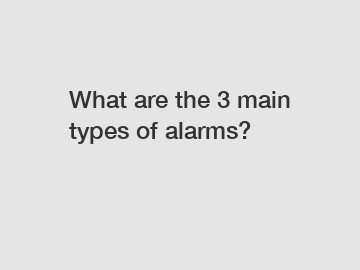What are the 3 main types of alarms?
In this digital age, security is a topmost priority for both residential and commercial spaces. Alarms play a crucial role in safeguarding property and ensuring personal safety. With an array of alarm systems available, it's vital to understand the different types and their functions. In this blog post, we will explore the three main types of alarms that continue to dominate the security industry, providing comprehensive protection and peace of mind.
1. Intrusion Alarms:
Intrusion alarms, also known as burglar alarms, are designed to detect unauthorized entry into a protected area. These versatile systems employ a combination of sensors strategically placed throughout a property. When triggered, they activate an audible alert, notify security personnel, or even contact emergency services. Intrusion alarms act as an excellent deterrent against burglaries, burglars, and vandalism.

The core components of an intrusion alarm system include:
a. Sensors: These devices detect unauthorized activities and include magnetic contacts, motion sensors, glass break detectors, and seismic and vibration sensors.
b. Control Panel: This serves as the brain of the system, receiving signals from the sensors, and activating appropriate responses.
c. Alarming Devices: These devices produce loud audible sirens and flashing lights to attract attention and deter intruders.
d. Communication Systems: Modern intrusion alarms can be connected to network systems to alert homeowners or monitoring centers via phone lines, mobile networks, or the internet.
2. Fire Alarms:
Fire alarms are designed to promptly detect the presence of fire or smoke and alert occupants to evacuate or take appropriate action. They are a vital component of any building, ensuring early detection and timely intervention to minimize property damage and save lives. Fire alarms can be classified into two main types:
a. Smoke Alarms: Smoke alarms are the most common type of fire alarm used in households. They contain sensors that identify smoke particles in the air, triggering an audible alert. Some advanced models can also connect to sprinkler systems or call the fire department automatically.
b. Heat Alarms: Heat alarms are predominantly used in commercial or industrial settings where the presence of smoke may be more common. These devices detect rapid increases in temperature and promptly sound an alarm, notifying individuals to take appropriate measures.
Fire alarm systems consist of the following components:
a. Fire Detectors: These devices include smoke detectors, heat detectors, and flame detectors, each serving different purposes based on the type of fire.
b. Control Panel: Similar to intrusion alarms, a control panel receives signals from detectors and activates appropriate responses, such as sounding alarms, engaging sprinklers, or notifying emergency services.
c. Emergency Lighting and Signage: These components ensure clear visibility and guide occupants towards safe exit routes during emergencies.
3. Carbon Monoxide (CO) Alarms:
Carbon monoxide is a silent killer, odorless, tasteless, and invisible. CO alarms are essential in homes and businesses, as they detect dangerous levels of carbon monoxide gas, enabling timely evacuation to prevent fatal poisoning. These alarms are typically positioned near fuel-burning appliances such as furnaces, water heaters, and stoves.
Key components of a CO alarm system include:
a. Carbon Monoxide Detectors: These sensors can detect and measure CO levels in the air and generate an audible alert when concentrations surpass safe thresholds.
b. Power Supply: CO alarm systems can be battery-operated or connected to a building's electrical supply. Backup batteries are recommended in case of power outages.
c. Alarm Notifications: Upon detecting unsafe levels of carbon monoxide, these alarms emit a loud sound, indicating immediate evacuation, as well as displaying visual alerts to ensure those with hearing impairments are adequately warned.
Conclusion:
Alarms systems are the first line of defense against various security threats, whether it's protecting against burglaries, fires, or carbon monoxide poisoning. Understanding the three main types of alarms - intrusion alarms, fire alarms, and carbon monoxide alarms - enables individuals to make informed choices when it comes to securing their property and loved ones. By investing in reliable and advanced alarm technology, you can sleep peacefully, knowing that your safety and security needs are well taken care of.
Contact us to discuss your requirements of hasl lead free, Industrial Control PCB Manufacturer, automotive pcb design . Our experienced sales team can help you identify the options that best suit your needs.



Comments
0